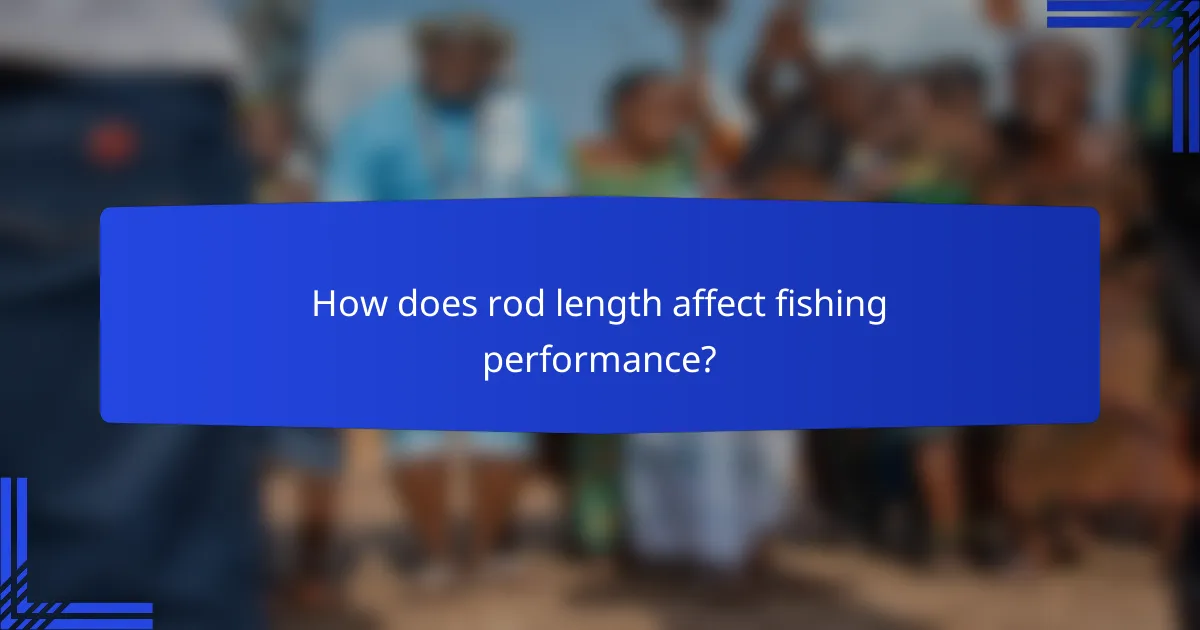Choosing the right fishing rod is essential for optimizing your experience on the water, particularly in diverse environments like New Zealand’s freshwater and saltwater. Key factors to consider include rod length, which affects casting distance and accuracy, and rod action, which determines how the rod bends under pressure. Additionally, the material of the rod can influence its sensitivity and durability, making informed selections crucial for successful fishing.

What are the best fishing rods for New Zealand waters?
The best fishing rods for New Zealand waters depend on the type of fishing you plan to do. Whether targeting freshwater rivers or saltwater coasts, selecting the right rod can enhance your fishing experience significantly.
Spin rods for versatility
Spin rods are ideal for a variety of fishing situations in New Zealand, making them a popular choice among anglers. They typically range from 6 to 10 feet in length, allowing for easy casting and control. A medium action rod is often preferred for its balance between sensitivity and strength.
When using spin rods, consider the type of reel and line weight that matches your target species. For example, a 10-20 lb line is suitable for catching species like snapper or trout, providing enough strength without sacrificing sensitivity.
Baitcasting rods for precision
Baitcasting rods offer greater accuracy and control, making them perfect for targeting specific spots in New Zealand’s waters. These rods usually range from 6 to 8 feet and are designed for heavier lures and lines, often between 10 to 30 lbs.
When choosing a baitcasting rod, look for a fast action tip that allows for quick hook sets. This is particularly useful when fishing for species like kingfish or large trout, where precision is crucial for success.
Fly rods for river fishing
Fly rods are specifically designed for casting lightweight flies, making them excellent for river fishing in New Zealand. Typically, these rods range from 8 to 10 feet in length and are rated by weight, commonly between 4 to 8 weights, depending on the target species.
When selecting a fly rod, consider the type of water and fish you are targeting. For example, a 5-weight rod is suitable for smaller streams and trout, while an 8-weight rod is better for larger rivers and species like salmon.
Surf rods for coastal fishing
Surf rods are built to withstand the rigors of coastal fishing in New Zealand, often measuring between 10 to 14 feet. These rods are designed for casting heavy weights over long distances, typically using lines rated from 15 to 50 lbs.
When using surf rods, pay attention to the action and power ratings. A medium to heavy action rod is recommended for targeting species like snapper or kahawai, ensuring you can handle the strong currents and larger fish common in coastal waters.

How does rod length affect fishing performance?
Rod length significantly influences fishing performance by affecting casting distance, accuracy, and leverage. Shorter rods offer precision, while longer rods enhance casting range, making the choice of length crucial based on fishing conditions and target species.
Short rods for accuracy
Short rods, typically ranging from 5 to 6 feet, excel in providing accuracy for close-range fishing. They allow for better control and precision when casting in tight spaces, such as under docks or around structures.
These rods are ideal for techniques like finesse fishing or when targeting species that require stealth. Anglers should consider using short rods in situations where precision is more valuable than distance.
Medium rods for balance
Medium rods, usually between 6 to 7 feet, strike a balance between casting distance and accuracy. They are versatile and suitable for a variety of fishing styles, making them a popular choice for both beginners and experienced anglers.
This length allows for effective casting in open water while still maintaining enough control for precise presentations. Medium rods are often recommended for general-purpose fishing, accommodating a wide range of techniques and species.
Long rods for distance
Long rods, generally exceeding 7 feet, are designed for maximizing casting distance. They are particularly useful in situations where anglers need to reach distant spots, such as in surf fishing or when targeting fish in large bodies of water.
While they provide the advantage of distance, longer rods can be more challenging to control, especially in tight quarters. Anglers should weigh the benefits of distance against the potential loss of accuracy when opting for a longer rod.

What is rod action and why does it matter?
Rod action refers to how much and where a fishing rod bends when pressure is applied, significantly influencing performance and technique. Understanding rod action helps anglers choose the right rod for specific fishing styles, enhancing their chances of success.
Fast action for quick hook sets
Fast action rods bend primarily at the tip, allowing for quick hook sets, which is crucial when targeting species that strike rapidly. This type of rod is ideal for techniques like jigging or topwater fishing, where immediate responsiveness is essential.
When using a fast action rod, anglers can expect a stiffer backbone, providing better control and leverage when reeling in fish. However, be cautious as this action can also lead to missed strikes if the angler is not attentive.
Medium action for versatility
Medium action rods offer a balance between flexibility and stiffness, making them suitable for a wide range of fishing techniques. They bend through the middle, allowing for both effective hook sets and good bait presentation.
This versatility makes medium action rods a popular choice for anglers who fish in various conditions and target different species. They can handle light to medium lures effectively, making them a solid option for beginners or those looking to simplify their gear.
Slow action for bait presentation
Slow action rods bend throughout the entire length, providing a gentle, parabolic curve that is excellent for bait presentation. This action is particularly effective when using live bait or soft plastics, as it allows for a more natural movement in the water.
While slow action rods can be less responsive for quick hook sets, they excel in situations where finesse is required. Anglers should consider using slow action rods in clear water or when targeting species that are wary of aggressive presentations.

Which materials are best for fishing rods?
The best materials for fishing rods include graphite, fiberglass, and composite blends, each offering unique advantages. Choosing the right material depends on your fishing style, target species, and personal preferences.
Graphite for sensitivity
Graphite rods are known for their sensitivity, making them ideal for detecting subtle bites. They are lightweight and provide excellent feedback, allowing anglers to feel even the slightest nibble.
However, graphite can be less durable than other materials, so it’s essential to handle them with care. They are best suited for freshwater fishing or lighter saltwater applications where finesse is key.
Fiberglass for durability
Fiberglass rods are renowned for their durability and flexibility, making them suitable for various fishing conditions. They can withstand rough handling and are less likely to break under stress, which is beneficial for beginners or those fishing in tough environments.
While they may lack the sensitivity of graphite, fiberglass rods excel in strength and are often used for heavier species like catfish or saltwater fishing. They are a solid choice for anglers who prioritize resilience over finesse.
Composite for balanced performance
Composite rods combine graphite and fiberglass, offering a balance between sensitivity and durability. This hybrid material provides a versatile option for anglers who want the best of both worlds.
Composite rods are suitable for various fishing styles and conditions, making them a popular choice among experienced anglers. They can handle a range of species and environments, ensuring you have a reliable rod for different fishing scenarios.

What factors should you consider when choosing a fishing rod?
When choosing a fishing rod, consider factors such as target species, fishing technique, and your budget. Each of these elements influences the rod’s length, action, and material, which are crucial for effective fishing.
Target species
Your target species significantly impacts the type of fishing rod you should select. Different fish require varying rod lengths and actions; for instance, a longer rod may be necessary for larger species like pike or salmon, while shorter rods are often better for panfish.
Additionally, consider the weight of the fish. Lighter species can be effectively caught with lighter rods, while heavier species may require sturdier, more robust rods to handle their strength.
Fishing technique
The fishing technique you plan to use also plays a critical role in rod selection. Techniques such as fly fishing, baitcasting, or trolling each have specific rod requirements. For example, fly fishing rods are typically longer and more flexible, allowing for better casting control.
Moreover, the action of the rod—whether fast, medium, or slow—should match your technique. Fast action rods provide quick response for techniques requiring precision, while slower action rods offer more flexibility for a gentle presentation.
Budget considerations
Your budget will determine the quality and type of fishing rod you can purchase. Fishing rods can range from low-cost options under $50 to high-end models exceeding several hundred dollars. It’s essential to find a balance between quality and affordability.
Consider investing in a mid-range rod if you fish frequently, as it will provide better performance and durability. However, for occasional anglers, a budget-friendly rod may suffice without compromising too much on quality.

How do fishing rod brands compare?
Fishing rod brands vary significantly in quality, performance, and price, making it essential to understand their strengths. Brands like Shimano are renowned for their craftsmanship, while others may focus on affordability or specific fishing styles.
Shimano for quality
Shimano is widely recognized for producing high-quality fishing rods that cater to a variety of fishing needs. Their rods often feature advanced materials and technologies, ensuring durability and sensitivity, which are crucial for successful fishing.
When choosing a Shimano rod, consider the specific type of fishing you plan to do. For example, their spinning rods are excellent for freshwater fishing, while their saltwater rods are designed to withstand harsher conditions. Prices typically range from moderate to high, reflecting the quality of materials used.
Common pitfalls include overlooking the rod’s action and length, which can significantly impact performance. Ensure you select a rod that matches your fishing style, whether it’s for casting, trolling, or bottom fishing.
